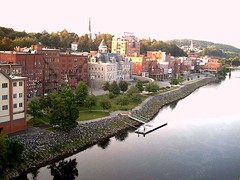Smaller cities can benefit from revitalization, too

Posted September 9, 2009 at 1:46PM
Andre Leroux, executive director of the Massachusetts Smart Growth Alliance, believes that New England's smaller cities hold the potential to absorb much development that could help save the region's countryside from sprawl. But it will take some policy reforms to realign incentives away from greenfield development and back to traditional centers.
Leroux writes in the Federal Reserve Bank's journal Communities and Banking that most small New England cities were once booming industrial centers, with robust populations, employment, shopping, and infrastructure.  But, like some of their larger counterparts, over time they became subject to considerable disinvestment in the form of plant closings, job losses, weakened civic infrastructure, and shrinking tax bases. In urban New England the losses were exacerbated by the region's traditional dependence on a manufacturing economy.
But, like some of their larger counterparts, over time they became subject to considerable disinvestment in the form of plant closings, job losses, weakened civic infrastructure, and shrinking tax bases. In urban New England the losses were exacerbated by the region's traditional dependence on a manufacturing economy.
Meanwhile, greenfield development prospered, to the effect that New England was losing some 1200 acres of undeveloped land each week before the current recession. As readers of this blog know well, across the country there has been an increasingly strong smart growth response to sprawl that has brought great new models of development. Ironically for New England, though, many of these models are based on design principles almost identical to those found in the smaller New England cities that suffered disinvestment. Leroux puts it this way:
"While sprawl was continuing in many suburbs, smart-growth developments nationwide were emulating the traditional patterns of small New England cities, with their lively and walkable squares, downtowns, and neighborhoods. Advocates of cities were drawing attention to their human scale, enriched by numerous amenities: railways, rivers, and parks; historic mills, homes, and churches; institutions such as museums, small colleges, and hospitals; diverse populations; and competitive housing and job opportunities."
 Leroux notes that various reviewers have used differing approaches to define the region's cities that are ripe for revitalization, emerging with overlapping but different lists. He highlights 18 of them in a sidebar, including Bridgeport, Hartford, Augusta, Holyoke, Pawtucket, and Burlington, among others.
Leroux notes that various reviewers have used differing approaches to define the region's cities that are ripe for revitalization, emerging with overlapping but different lists. He highlights 18 of them in a sidebar, including Bridgeport, Hartford, Augusta, Holyoke, Pawtucket, and Burlington, among others.
Leroux's seven-step plan for ripening the reinvestment opportunity includes the following:
- Improve neighborhoods and urban parks, instituting foreclosure prevention activities to head off future abandonment and displacement.
- Invest in civic life to create a more participatory citizenry.
- Develop transparent municipal systems.
- Prioritize state infrastructure investments that strengthen smaller industrial cities as opposed to supporting infrastructure sprawl.
- Level the development playing field and institute state policies that expose the hidden long-term costs of greenfield development could help.
- Sixth, support education reform and lifelong learning.
- Finally, incubate the green economy.
 Former mill cities could be ideal for industries like green manufacturing, construction, and energy partly because they offer inexpensive start-up space.
Former mill cities could be ideal for industries like green manufacturing, construction, and energy partly because they offer inexpensive start-up space.
I bolded the two that, from my perspective, seem especially important. Reforming infrastructure investments won't be easy, though. Read the whole article here.
As I reported earlier, Grow Smart Rhode Island has weighed in on the related issue of how a more targeted economic development strategy could aid revitalization by focusing on businesses whose operations are well-suited to adaptation of older building stock. Many of the examples highlighted by Grow Smart involve the information economy.
When the recession eases, the timing will be good. Americans are clearly shifting their preferences toward more living and working in cities and walkable communities.